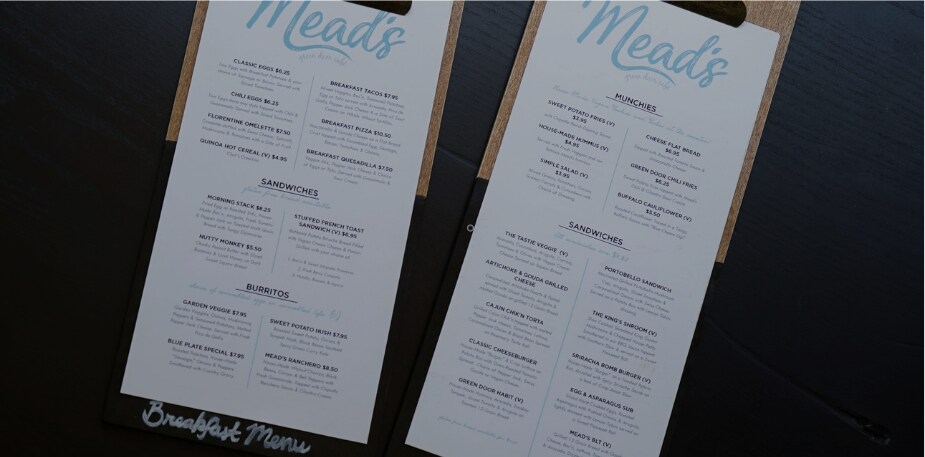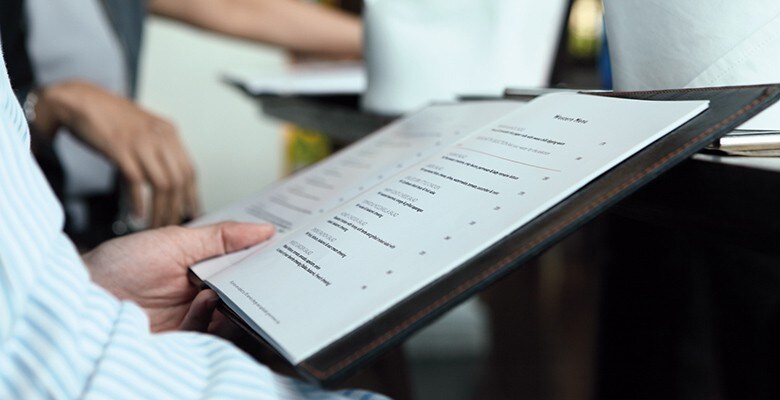A restaurant’s menu sets the stage for a memorable dining experience. Not only is it about the types of food on the menu, but also how they are priced, described, and portrayed on it. Great menu planning could bring in up to 15% more sales and boost your profitability1.
Why is menu planning important?
Having a proper plan for your menu allows you to purchase and store food more effectively, because everything is planned ahead of time. This means that there will be less food wastage, as ingredients are maximised across all food items, thus saving you money.
Read on for a guide on how to plan the best menu that will differentiate your business from your competition.
1. Align menu with your restaurant concept

Your menu sets the mood for your restaurant and gives customers an insight into your concept. Just the colour of your menu alone is enough to make your offerings look more appealing2.
That’s why the first step to menu planning would be to define your restaurant’s concept. Consider the following aspects when defining it:
- The type of cuisine you intend to serve.
- The style of your restaurant, whether it’s more casual or formal.
- The types of meals you wish to feature, whether it’s a full menu, or only offers drinks and appetisers.
Next, come up with a list of core ingredients within your menu that will excite your customers. As much as possible, use these ingredients in various dishes on your menu to keep costs down. Pick ingredients that are readily available all year round and stable in price.
Then comes the question of how many menu items you should have. More isn’t always better, as studies have shown that customers are more likely to be dissatisfied with their decision if given more options to choose from3. While there is no magical number, an ideal goal would be to keep it under 30 items to maximise productivity and ensure all items can be prepared quickly.
2. Categorise menu items

No one likes to be held back from food when hungry. To ensure that customers can find menu items easily, your menu must be well-organised. This means sorting menu items into clear categories such as appetisers, main courses, desserts, etc. Managing your inventory will naturally become easier when the menu is organised well.
Feature your star dishes prominently in the menu, be it on the top of the menu or on the first page. If you wish to include plant-based dishes into your menu, don’t place them in a separate section, but integrate them with other dishes and use small symbols to indicate that they are vegan or vegetarian-friendly. Learn how you can market plant-based foods in your restaurant menu!
3. Set menu prices

Setting menu prices is a delicate process that requires careful consideration of numerous factors. Go too high and you risk turning customers away; too low and your restaurant will not be able to make a profit.
To reach a healthy balance that will benefit your restaurant while staying within your customers’ price tolerance, consider these 3 key factors when setting your menu prices.
- Food cost percentage: Your food cost percentage calculates the portion of your revenue that is spent on your food inventory. Most restaurants’ food cost percentage fall within the range of 28-35%4. Aim to lower your food cost percentage to turn more sales into profit.
- Raw food cost: Your raw food cost will be the total cost of all ingredients used to make up a dish.
- Competitor’s pricing: Take reference from how your competitors are pricing their menu items, and price your items comparably to them — marking your price up or down depending on the disparity of popularity, ambience, and service between your restaurant and your competitor’s.
Read on to learn How to Price Menu Items for Profit and get more Tips to Price your Menu Right.
4. Create menu descriptions

The average customer will spend about 90 seconds reading a menu5, so it must be able to capture interest at first glance. A good menu description will bring in more sales as it effectively communicates that your food is delectable and worth trying.
One key thing that most restaurants do is to highlight the more premium ingredients in the menu such as king salmon or winter truffle, to steer guests into thinking that the food is of higher quality. Read more to find out How to Write Food Menu Descriptions that Sells, and follow the 4 essentials below to write a compelling menu description.
- Keep descriptions short and concise. Feature one or two lines maximum, so that you don’t risk losing your customers’ attention.
- List all the ingredients of a dish, so guests know exactly what they’re ordering.
- Include the geographical origin of any dish to make it sound more exclusive and unique, so guests will be intrigued to know how it tastes.
- Use descriptive and alluring adjectives to describe your items, such as “refreshing”, “tangy”, “succulent” and “pan-seared”.
5. Design your menu

The design of your menu is the first thing that your customers see. No matter how delicious your food is, it will not matter as much as how well your menu is designed, because as the saying goes, people eat with their eyes first.
A well-designed menu gets customers excited for their meal and clearly conveys what your restaurant has to offer. These are 5 important aspects to master when designing your menu:
- Positioning: The positioning of items on your menu will influence what customers see first. With a bi-fold menu, people are likely to read it like a book, from left to right6. Place your more popular and profitable dishes as the first and last menu items, because those are the ones that your customers will most likely remember7.
- Formatting: A cluttered menu may be frustrating to read. Ensure there is enough white space in between your menu items or categories and keep your descriptions short and sweet.
- Colours: Colours can evoke various emotions that influence customers’ opinion of your restaurant or menu items2. Use vibrant colours to draw attention to your star dishes, or use green to highlight the more healthy food items on your menu.
- Font: Stick to 1 or 2 complementary fonts to keep your design looking harmonious and choose more readable fonts like Arial and Open Sans.
Great menu planning will set your business up for success. It can give your customers a positive first impression of your restaurant and even direct their attention on the more profitable menu items. That’s why it’s a worthy investment and helps your restaurant stand out in the competitive market.
References
1. https://www.menucoverdepot.com/resource-center/articles/restaurant-menu-engineering/
2. https://www.business.com/articles/how-to-color-restaurant-food/
3. https://hbr.org/2006/06/more-isnt-always-better
4. https://smallbusiness.chron.com/common-food-labor-cost-percentages-14700.html